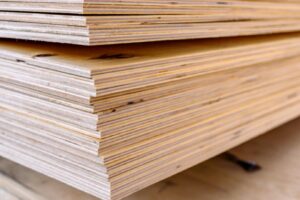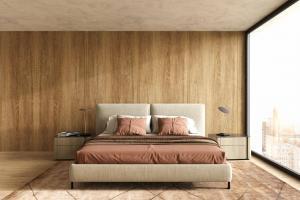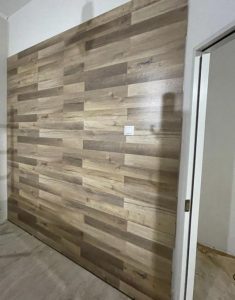Plywood is ideal for use in bathrooms because of its strength, moisture resistance, and adaptability for any residential construction project. Choosing the best plywood for bathrooms depends on what you’re building, how strong you need the surface to be, and the finish you’d like to achieve.
You can use plywood to build a bathroom vanity, construct decorative wall paneling around a tub, and for subflooring to strengthen the floor to withstand everything a bathroom holds (like people, a water-filled tub, vanity, and heavy floor tiles).
Keep reading to learn the best plywood for bathroom floors (including subfloors), walls, and vanities.
Can I Use Plywood For Bathrooms?
Yes, plywood can be used for bathrooms, provided you choose the right plywood type. You can use plywood to build bathroom cabinets, decorative wall panels, and subfloors. The best type of plywood to use in a bathroom is one that can withstand moisture exposure.
Bathrooms are humid and water frequently drips on cabinets during daily use, so you should use plywood categorized as Exposure 2 (which is suitable for interiors where slight moisture is expected). Exposure 1 plywood is also fully waterproof (due to the glue used to bond the plies together) but may be too waterproof for most bathroom projects.
Neither of these plywood types can be used externally, as they cannot withstand all weather. Exterior or pressure-treated plywood should be used for any outdoor projects where deep, permanent, and routine water exposure is expected.
Is Plywood Waterproof For Bathrooms?
All plywood is somewhat waterproof, but you need to choose plywood suitable for prolonged moisture exposure for use in the bathroom. This is because standard plywood, even those of a high grade, will not be fully waterproof to withstand the humidity and daily exposure to drips. Moisture-resistant plywood is widely available, but may be termed differently in stores.
For general use in the bathroom, choose either Marine Plywood graded as Water Boiled Proof (WBF), Hardwood Plywood made with waterproof glue/resin, or waterproof plywood with a Birch core. Look for plywood labeled as waterproof, Exposure 1, Exposure 2, or pressure-treated when finding the best plywood for bathrooms.
Plywood used in bathroom woodworking projects, like wall paneling, vanities, or cabinets, is only as waterproof as its finish. While waterproof plywood alone will withstand the humidity and won’t become wet and warped, using an unsuitable paint, stain, varnish, or lacquer to finish your handiwork will lead to surface-level peeling, staining, or fading. When finishing plywood, always choose a finish that’s suitable for bathrooms.
Can I Use Plywood On Bathroom Walls?
Yes, waterproof plywood can be used on bathroom walls. Most people use plywood to create decorative wall panels or as wall supports before tiling. Tiles are one of many materials that stick to plywood, provided the wall is suitably prepared beforehand.
Using plywood as wall supports or a substrate to provide structural strength in a bathroom needs careful consideration. Tiles only stick to plywood if certain grades are used. The texture, moisture level, porosity, chemical treatment, and flexibility of the plywood impact how well the adhesive sticks. You’ll need to either use plywood tiles stick to, use a prime sealer, or purchase a suitable adhesive if you plan on tiling over plywood walls.
Using plywood as decorative wall paneling, like shiplap or wainscoting is much easier. You can use any plywood that has some resistance to moisture for bathroom wall panels, particularly if the paneling will be shaped around a bath, sink, or vanity. You should also ensure the finish you apply is waterproof to prevent peeling, flaking, or fading.
Can I Use Plywood For Bathroom Vanities?
Plywood can be used for bathroom vanities and cabinets. It’s ideal for bathrooms because it’s strong, sturdy, and moisture-resistant. You can use plywood for the construction of the shelves, drawers, and doors.
Typically, softwood plywood (which is affordable and widely available) can be used for the two sides, the bottom, and the back. For the doors, close-grained hardwood (also known as Cabinet Grade Plywood) can be used. However, if you plan on painting the vanity, you can use a mildly waterproof softwood for the doors to save on costs.
When using plywood to build a basic bathroom cabinet, you’ll need to construct large boxes and subdivide them to create the different compartments (the shelves and drawers). Read our guide on how to create a basic cabinet using plywood to learn more.
Is Plywood Good For Bathroom Floor?
Yes, you can use certain types of plywood for bathroom subfloors. However, you should not use it as visible flooring for bathrooms. Because plywood isn’t completely resistant to moisture, it’s best to install an underlayment of concrete backer board to fully protect the plywood subfloor from moisture, and an overlay, like tiles.
What Plywood Should I Use For Bathroom Floors?
Bathroom subfloors need to be strong, waterproof, and contain minimal knots and voids. When using plywood for subfloors in a bathroom, you need to select Exterior or moisture-resistant plywood. These can withstand the humidity created daily from showering and bathing.
The type of plywood you need depends on what you’re laying on top of the subfloor. Most people lay tiles (made from ceramic, porcelain, or stone), hardwood flooring, or laminate in bathrooms. Tiles only stick to certain plywood, so check what sticks to plywood before starting your subfloor.
If you’re laying ceramic tiles, porcelain tiles, or laminate over a bathroom subfloor, AC plywood, coupled with a cement backer board, is best. This underfloor will prevent the plywood from warping or bending, which will minimize the risk of tile cracking. Learn more about how to prepare plywood subfloor for tiling.
When laying hardwood flooring over a plywood subfloor, CDX plywood with AC grade is best. Plywood that fits together with tongue and groove fastenings is also recommended under hardwood flooring. This ensures the flooring is flat, strong, and doesn’t squeak.
Laying stone tiles atop plywood flooring requires a strong base. This is because natural stone tends to be heavier than any other flooring overlay. The best plywood type is tongue and groove plywood. Depending on the weight of the stone, you should consider reinforcing the subfloor with two layers of plywood and a requisite underlayment.
How Thick Should Plywood Be For Bathroom Floors?
Choosing the right plywood thickness is important for bathrooms. You’ll need to consider the maximum weight you need your subfloor to hold. You’ll need to ensure your floor is strong enough to withstand a water-filled tub, daily household use, and the weight of the overlay. For example, if you’re laying heavy ceramic, porcelain, or stone tiles.
Here’s an overview of the best plywood for bathroom floors for different overlays and what thickness you should choose.
| Type of Overlay | Type of Plywood to Use | Thickness |
| Ceramic Tiles, Porcelain Tiles, or Laminate | AC Plywood | ¾ inch |
| Hardwood | CDX Plywood Grade AC | 5/8 – ¾ inch |
| Natural Stone Tiles | Tongue and Groove Plywood | 19/32 inch overlaid with 15/32 inch plywood, with a 1/3 inch gap between each |
Closing Summary: Things to Remember
As you can see, plywood is versatile for residential bathroom construction. You can use it to build a vanity (complex or basic), as a subfloor, as wall paneling, or as structural support for floors. Choosing the best plywood for bathrooms is the most important stage in the planning of your woodworking project.
Remember, the most critical things to remember when using plywood in bathrooms are:
- Not all plywood is waterproof and suitable for bathrooms
- Plywood can be treated to become moisture-resistant or purchased with waterproof glue that prevents warping and breakage when wet
- When using plywood in bathrooms, ensure you finish it with an equally waterproof solution, like a moisture-resistant paint, wax, stain, lacquer, or varnish
- You’ll need to use different plywood for bathroom floors depending on what you plan on using for overlay
- Weight and thickness of plywood must be tailored to suit the specifics of your bathroom to ensure it meets the maximum weight capacity
Provided you plan your woodworking project suitably and use the right type, using plywood in the bathroom is ideal for its reliability, strength, and affordability.




